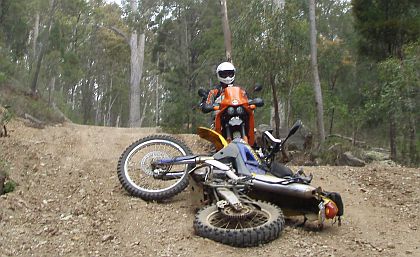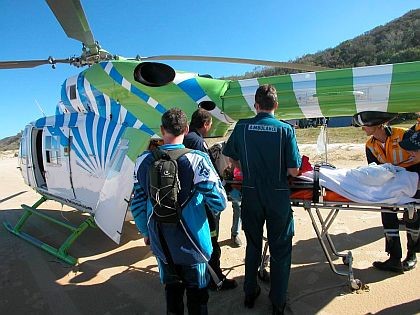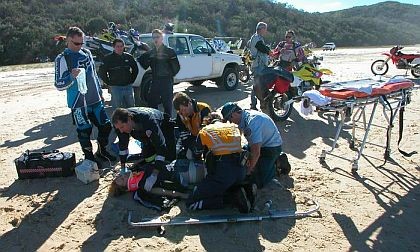Ouch! Get Me Out of Here Now!
Going Down
Eventually you will be involved in an emergency situation, with either you or a mate injured. If you’re smart, you will have done a first aid course or two and have a clear understanding of how to treat wounds. If not, the key is to respond quickly and efficiently, without panic.

The well-established DRABC plan has it all. At the very start look for Danger. If the rider is laying on the track, is there a chance of him being hit by another vehicle? Is the bike leaking fuel? If he’s under the bike, is he clear of hot headers and mufflers? Take it in at a glance and position other riders as a protective shield, or to help move the bike or rider. Don’t put other riders at risk; if at all possible position people up and down the track to stop oncoming traffic.
Once the area is secure, check the injured rider. Response is what you’re looking for. Is he conscious? If so, is he lucid? Ask his name, what day it is, or what his younger sister’s phone number is, and evaluate the response. If he’s unconscious, roll him onto his side and check his airway, by tilting his head slightly back and down, then opening his mouth to check for debris, blood and broken teeth. Now check for Breathing. Is the chest rising and falling? Can you feel his breath? If he’s not breathing begin EAR (Expired Air Resuscitation) immediately: mouth to mouth with your riding mates isn’t fun, but it could save a life. Finally, check for Circulation, by feeling for the carotid pulse in the neck. If there is no pulse, start CPR immediately. Once you are sure the rider is breathing and pumping, begin to manage any bleeding and be prepared for him to go into shock.
One thing should be obvious right now. If you don’t know how to resuscitate or do CPR, you are not equipped for an emergency in the bush. Sign up for that first aid course today. For more info click here
Assessing a Fast Exit
Once the injured rider is stable, you will need to formulate a plan. If the injury is a light one, such as a strain or a small wound, you can attempt to get him out either on his own bike, or on the back of someone else’s. If this approach is taken, do it as soon as possible while he is still full of adrenaline, and don’t look at more than an hour or riding tops, because after that shock will start to set in.
If you have a support vehicle, is getting it in viable? Remember that 4WDs can easily take twice as long as a bike to cover a track. Ambulances are useless in the bush because of the weight of the equipment they carry. You might consider meeting an ambulance at the nearest well-formed road, and discuss this with the staff at the emergency call centre.
Most of the time, though, a serious injury calls for a helicopter evacuation, which is why only complete nutters ride without ambulance cover. A chopper ride costs a fortune, and if you aren’t covered you could easily cop a bill of $5,000 or more. Ambulance insurance costs around $35 a year; work it out for yourself.
Calling for assistance in an emergency should be done quickly and efficiently - see Communications section. 000 or 112 will get you to the emergency call centre where you will be asked whether you require police, fire or ambulance, and your location. At this point, you should give your general location, such as in the Great Divide 40ks inland from Kempsey. The operators know the major towns, so these are the best places to work from. You will then be put through and asked to describe the injuries. Be clear about this. Suspected broken leg below the knee. Unconscious but breathing, then quote heart rate. Head injury, memory loss, general disorientation. You don’t need to be a medical expert, but you do need to communicate the symptoms effectively so gather as much information as quickly possible before making the call, especially if you have to send a rider to another location to call for help.
The emergency operator will then assess the best way to send help. At this point you will be asked to pin-point your location, so a GPS is very handy. Quote the coordinates in Lat and Long, because the choppers fly using this nav system. Failing this, track names are almost as good, particularly if you can give the track you’re on and the distance and direction of the closest cross track. Maps are therefore essential. No map or GPS makes it very hard for the rescue services. You’ll have to fall back on ‘10ks west of Big Knob’ and guide the chopper in by smoke or flashing lights, but chances of a rapid recovery without adequate info are slim.

Preparing for Evacuation
Once a medivac has been arranged, keep the injured rider as comfortable as possible. Use jackets and even a fire to keep him warm if it’s cold, shelter him from the sun if it’s hot, and avoid giving him food if there is the slightest chance of him needing an operation. Keep his spirits up with friendly chatter and never show fear, no matter how scared you may be.
This is a good time to consider how you’re going to get his bike out and make arrangements for this to happen. It may also be sensible to get the main body of the group moving again, leaving a small group of three or four to deal with the evacuation. There’s no point in everyone riding out in the dark and risking further injuries.
In thick bush the injured rider may need to be evacuated by winch, so prepare for this. Choppers create a hell of a down-draft, so clear the area of loose objects like branches, jackets, helmets and bikes, and put the signal fire out properly or it will start up again and you’ll be running through the bush putting bits of it out everywhere. Keep your goggles and wear them when the chopper arrives because the dust will be horrendous. Put the patient’s goggles on him as well, and shelter him as much as possible.
Often a paramedic will be dropped in with a stretcher and the chopper will move away. Help the paramedic by supplying concise information about the injury and obeying all his instructions. Keep chat to a minimum. Three riders should be close at hand to help; the rest should keep back to allow the others room to work. You may have to help by preparing the stretcher, moving the rider onto the stretcher, or as a dogman steadying the paramedic and rider with a rope as they are winched back to the chopper.

Stay In Control
Once the injured rider has been passed to safer hands, get yourself out of the bush calmly and competently. Chances are it will be getting dark, so take extra care because chopper pilots hate going to the same place twice. Do not rush, do not take risks to make up time, and do not try to complete a ride when there is a quicker way home via a road.
But the point to remember above all others is that accidents can be avoided. Ride within your limits and you won’t be the one on the stretcher.
